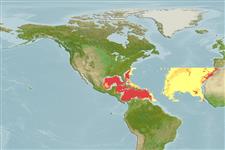>
Notacanthiformes (Halosaurs and deep-sea spiny eels) >
Halosauridae (Halosaurs)
Etymology: Aldrovandia: Taken from Ulisse Aldrovandi, (1522-1605), a Renaissance naturalist and physician noted by his systematic and accurate observations of plants and animals (Ref. 45335).
More on authors: Goode & Bean.
Environment: milieu / climate zone / depth range / distribution range
Écologie
marin bathypélagique; profondeur 460 - 2560 m (Ref. 4448). Deep-water; 36°N - 9°N
Eastern Atlantic: Western Sahara to Sierra Leone. Western Atlantic: Virginia, USA to the Lesser Antilles, mainly the Gulf of Mexico and Caribbean. The only record off Nova Scotia is doubtful.
Taille / Poids / Âge
Maturity: Lm ? range ? - ? cm
Max length : 55.0 cm TL mâle / non sexé; (Ref. 4448)
Description synthétique
Morphologie | Morphométrie
Few gill rakers on the 1st branchial arch. Short maxillary spine and the broad and scaleless interorbital region. Peculiar structure of lateral line. Grayish white in color (Ref. 37108).
Found on the continental slope and rise. Feeds mainly on benthic organisms which includes pelecypods, amphipods, mysids, polychaetes and ophiuroids (Ref. 4448).
Life cycle and mating behavior
Maturité | Reproduction | Frai | Œufs | Fécondité | Larves
Sulak, K.J., 1990. Halosauridae. p. 126-132. In J.C. Quero, J.C. Hureau, C. Karrer, A. Post and L. Saldanha (eds.) Check-list of the fishes of the eastern tropical Atlantic (CLOFETA). JNICT, Lisbon; SEI, Paris; and UNESCO, Paris. Vol. 1. (Ref. 4448)
Statut dans la liste rouge de l'IUCN (Ref. 130435)
Menace pour l'homme
Harmless
Utilisations par l'homme
Plus d'informations
Noms communsSynonymesMétabolismePrédateursÉcotoxicologieReproductionMaturitéFraiRassemblement de ponteFéconditéŒufsDéveloppement de l'œuf
Taille/ÂgeCroissanceLongueur-poidsLongueur-longueurFréquences de longueursMorphométrieMorphologieLarvesDynamique des populations larvairesRecrutementAbondanceBRUVS
RéférencesAquacultureProfil d'aquacultureSouchesGénétiqueElectrophoresesHéritabilitéPathologiesTraitementNutrientsMass conversion
CollaborateursImagesStamps, Coins Misc.SonsCiguateraVitesseType de nageSurface branchialeOtolithesCerveauxVision
Outils
Articles particuliers
Télécharger en XML
Sources Internet
Estimates based on models
Preferred temperature (Ref.
123201): 4.4 - 9.5, mean 5.4 °C (based on 237 cells).
Phylogenetic diversity index (Ref.
82804): PD
50 = 0.5156 [Uniqueness, from 0.5 = low to 2.0 = high].
Bayesian length-weight: a=0.00087 (0.00033 - 0.00229), b=3.07 (2.84 - 3.30), in cm total length, based on LWR estimates for this (Sub)family-body shape (Ref.
93245).
Niveau trophique (Ref.
69278): 3.3 ±0.40 se; based on food items.
Résilience (Ref.
120179): Milieu, temps minimum de doublement de population : 1,4 à 4,4 années (Preliminary K or Fecundity.).
Fishing Vulnerability (Ref.
59153): Moderate vulnerability (42 of 100).
